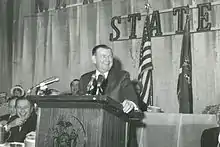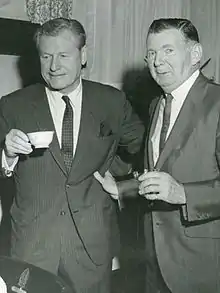Earl Brydges
Earl William Brydges (May 25, 1905 – March 30, 1975) was an American lawyer and politician from New York. He was Temporary President and Majority Leader of the State Senate from 1966 to 1972.[1]
Earl W. Brydges | |
|---|---|
 | |
| Member of the New York State Senate from the 52nd district | |
| In office 1967–1972 | |
| Preceded by | Tarky Lombardi, Jr. |
| Succeeded by | Frederick L. Warder |
| Member of the New York State Senate from the 60th district | |
| In office 1966–1966 | |
| Preceded by | Created |
| Succeeded by | Abolished |
| Member of the New York State Senate from the 54th district | |
| In office 1955–1965 | |
| Preceded by | Stanley J. Bauer |
| Succeeded by | Theodore D. Day |
| Member of the New York State Senate from the 52nd district | |
| In office 1949–1954 | |
| Preceded by | William Bewley |
| Succeeded by | George T. Manning |
| Personal details | |
| Born | Earl William Brydges May 25, 1905 Niagara Falls, New York |
| Died | March 30, 1975 (aged 69) Lewiston, New York |
| Political party | Republican |
| Spouse(s) | Eleanor C. Mahoney |
| Children | 7 |
| Alma mater | Niagara University University at Buffalo Law School |
Early life
Earl William Brydges was born on May 25, 1905 in Niagara Falls, New York. He graduated from Niagara University and the University at Buffalo law school in 1926. Later he served for many years on Niagara University's board of trustees. He was admitted to the bar in 1927.[1]
Career
Brydges served on the Board of Education in Wilson, New York during the 1940s. He also was active in educational advocacy organizations in Western New York.[1]
He was a member of the New York State Senate from 1949 to 1972, sitting in the 167th, 168th, 169th, 170th, 171st, 172nd, 173rd, 174th, 175th, 176th, 177th, 178th and 179th New York State Legislatures.[1]
For the majority of his Senate career, Brydges focused mainly on educational policy and mental health issues. His focus within the area of mental health was on improving services for the mentally retarded and special education students. His education policy focus was on K-12 education policy statewide.[2] Brydges served as Chairman of the Senate Education Committee and Chairman of the Senate Special Committee on Mental Health.[1]
Senate Majority Leader
In 1965, when the Republican Party lost the majority in the State Senate for the only time since 1939, Brydges was elected Minority Leader of the Senate.[3] Court ordered voting rights redistricting lead to senators serving one year terms in 1965 and 1966. The Republican Party regained the majority in 1966, and Brydges became Majority Leader.[4] He was a delegate to the New York State Constitutional Convention of 1967.[1]
As Majority Leader, Brydges worked closely with Gov. Nelson Rockefeller on policy development and legislation. His main focus continued on educational issues, along with upstate economic development. He worked with Rockefeller to create the State University of New York system and to develop new school state aid funding formulas. Brydges worked with Rockfeller in the creation of new state agencies and reorganization of the New York City mass transit system. As Majority Leader, Brydges remained an advocate for Western New York and tourism development in Niagara County. He was an early supporter of casino gambling in Niagara Falls. In 1972, Brydges successfully passed legislation to legalize casino gaming in New York State through an amendment to the state constitution. The casino amendment did not pass in the end, since the state constitution requires the passage of legislation in two consecutive legislative sessions and then passage of the majority of the state's voters in a statewide referendum. Brydges' vision in the area of casino gaming was realized with the opening of the Seneca Niagara Casino on January 1, 2003.[1]
Brydges was a fierce advocate for the pro-life movement and blocked legislation to legalize abortion in New York. In 1970, Brydges allowed the Senate to vote on legislation to legalize abortion. He did so under the belief the Senate would not pass the bill. When the Senate surprised him and passed the bill, which had already passed the Assembly and had the support of Governor Rockefeller, Brydges reportedly sat in his Senate chair and wept.[1][5]
Acting Governor of New York

In 1972, both Rockefeller and Lt. Gov. Malcolm Wilson left the state on the same afternoon. Under the state constitution, this made Brydges the Acting Governor of New York for several hours. As acting governor, Brydges signed routine state paperwork and conducted Senate business. He did not sign any legislation into law, including a pending bill relating to Niagara Falls that he had sponsored.[1]
In 1972, Brydges did not seek reelection to the Senate and he retired on January 1, 1973.[1][6]
Personal life
He married Eleanor C. Mahoney. Together, they had five sons and two daughters, including:[1]
- Earl W. Brydges, Jr., who married Martha Ann Shalala in 1967.[7]
- Thomas Eugene Brydges, who married Roxanne Catherine Hammer in 1972.[8]
- William Brydges[8]
- Margaret Brydges[8]
Brydges died of cancer in 1975 and his funeral was attended by then Vice President Rockefeller.[1] This was Rockefeller's first visit to Upstate New York as vice president.
Honors
The Earl W. Brydges Artpark in Lewiston, New York, an outdoor theater and concert center that he championed, was named in his honor. In addition, the main public library in Niagara Falls, the Earl W. Brydges Library, designed by architect Paul Rudolph, was named after him.
References
- Hudson, Edward (March 31, 1975). "Earl Brydges Dies of Cancer; State Senate Republican Leader". The New York Times. Retrieved 20 October 2016.
- Times, Special To The New York (17 December 1968). "BRYDGES QUESTIONS CITY SCHOOL PLAN". The New York Times. Retrieved 20 October 2016.
- Times, Special To The New York (27 November 1965). "STATE SENATORS TO NAME LEADER; Brydges Likely to Get Post at G.O.P. Meeting Dec. 6". The New York Times. Retrieved 20 October 2016.
- Times, Sydney H. Schanberg Special To The New York (21 February 1966). "DEMOCRATS HALT ALBANY PARLEYS ON REDISTRICTING; | Travia Declares Compromise Efforts Are at Impasse Urges Court Act | G.O.P. CHIEF SURPRISED | Brydges Charges Decision Was Made by Top Echelon Leaders on Outside Reapportionment Negotiations Are Called Off in Legislature". The New York Times. Retrieved 20 October 2016.
- https://www.nytimes.com/2000/04/09/nyregion/70-abortion-law-new-york-said-yes-stunning-the-nation.html
- Times, William E. Farrell Special To The New York (3 January 1973). "Legislature Opening Session Today; Debate Foreseen on Budget Surplus". The New York Times. Retrieved 20 October 2016.
- Winter, Ellore (10 September 1967). "Martha Ann Shalala Married To Earl William Brydges Jr". The New York Times. Retrieved 20 October 2016.
- Times, Special To The New York (25 November 1972). "Miss Hammer, T. E. Brydges Marry Upstate". The New York Times. Retrieved 20 October 2016.
| New York State Senate | ||
|---|---|---|
| Preceded by William Bewley |
New York State Senate 52nd District 1949–1954 |
Succeeded by George T. Manning |
| Preceded by Stanley J. Bauer |
New York State Senate 54th District 1955–1965 |
Succeeded by Theodore D. Day |
| Preceded by new district |
New York State Senate 60th District 1966 |
Succeeded by district abolished |
| Preceded by Tarky Lombardi, Jr. |
New York State Senate 52nd District 1967–1972 |
Succeeded by Frederick L. Warder |
| Political offices | ||
| Preceded by Joseph Zaretzki |
Minority Leader in the New York State Senate 1965 |
Succeeded by Joseph Zaretzki |
| Preceded by Joseph Zaretzki |
Temporary President of the State Senate 1966–1972 |
Succeeded by Warren M. Anderson |
